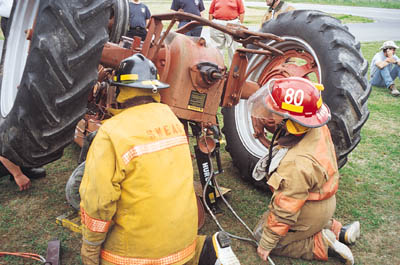To The Rescue: EMT Training Could Save A Farmer’s Life

Split-second decisions by emergency personnel can mean the difference between life and death for a farmer trapped beneath an overturned tractor or tangled in a PTO shaft. And for emergency medical technicians, the equipment used by farmers poses an entirely new set of obstacles and dangers.That’s why the Birmingham Regional Emergency Medical Services System (BREMSS) sponsors specialized training several times a year to prepare emergency medical technicians (EMTs) and other emergency personnel in a six-county area how to react to those situations. BREMSS serves emergency personnel in Blount, Chilton, Jefferson, Shelby, St. Clair and Walker counties and is one of six such regional facilities in the state.A training session recently was held in Blount County at the Nectar Volunteer Fire Department where about 30 EMTs and other emergency personnel were trained in farm rescue techniques. The Blount County Farmers Federation was among the sponsors of the program.”We felt this was an important program because the great majority of EMTs don’t know anything about the equipment we use on the farm,” said Blount County Farmers Federation President Denny Armstrong. “This training benefited both the EMTs and the farmers who might one day need their help. The accidents that happen on a farm are very different than accidents that happen most any where else. This training taught them about some of the different equipment and some of the chemicals you might find on a farm.”John Reed, the education coordinator for BREMSS, said about 100 EMTs and other emergency personnel go through the training each year. A program similar to the one held recently in Blount County was held in Walker County last fall.”We had a trauma surgeon and a trauma nurse on the program as well as chemical experts,” Reed said. “Farm accidents are unique because there are so many variables. When we’re called to a car accident, we pretty much know how the car operates. But so much of the farm equipment is specialized, if you don’t know what you’re doing, you can end up causing more harm to the victim, or in some cases, the EMT could injure himself and others.”According to farm safety experts with the U.S. Department of Agriculture, most traumatic farm injuries occur during interactions with machinery, especially tractors. But injuries also result from electrical power, livestock handling and weather conditions.The USDA report said tractor accidents have been identified as the leading cause of deaths and disabling injuries on farms. Tractor accidents account for one-third to one-half of fatal farm accidents.”Of course safety is the best way to prevent any accident from happening in the first place,” Reed said. “But when an accident does occur, the first few steps that are taken can mean the difference in someone’s life.”Reed said when an accident happens, the emergency 911 should be called as soon as possible. The type of equipment should be included in the information given to the emergency personnel over the phone, he said.”Do not try to free a victim because sometimes more damage can be done than if you had waited for trained personnel to arrive,” Reed said. “Also, if heavy equipment is involved, you could injure yourself while trying to move the equipment.”Farmers working alone are especially at risk if an accident occurs, Reed said. If a farmer is working alone, he should leave specific instructions for what he will be doing, where he is going and what time he will be finished.”Farmers also should have some form of communication with them such as a cell phone or two-way radio,” Reed said. “With the communication tools we have available today, all farmers should have one or the other of these with them at all times.”The course was offered free to the emergency personnel, most of which are volunteers with their local fire departments, Reed said. Sponsors such as the Farmers Federation help cover the costs for the personnel who put on the training programs.
